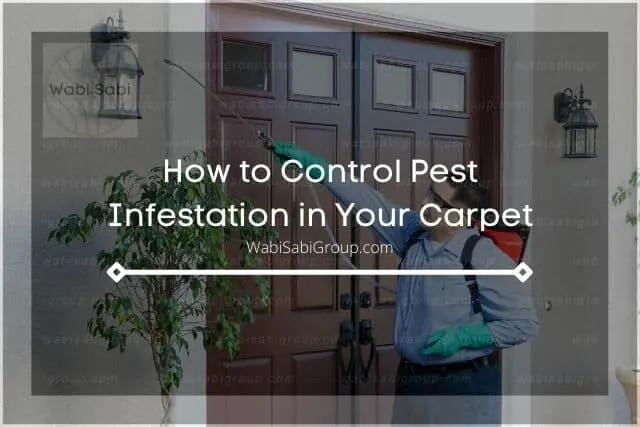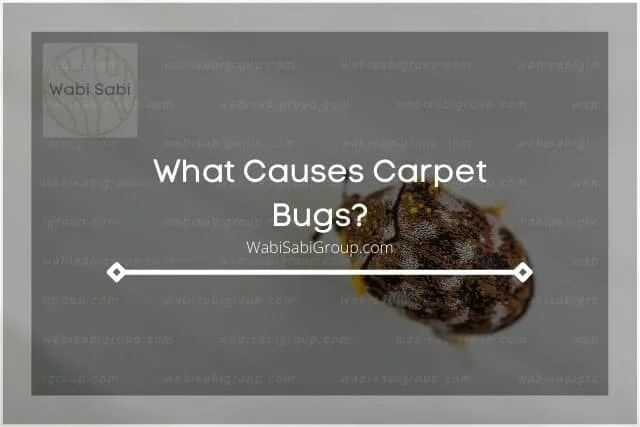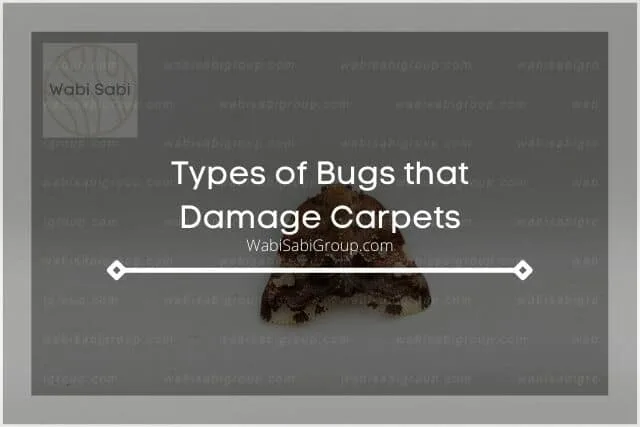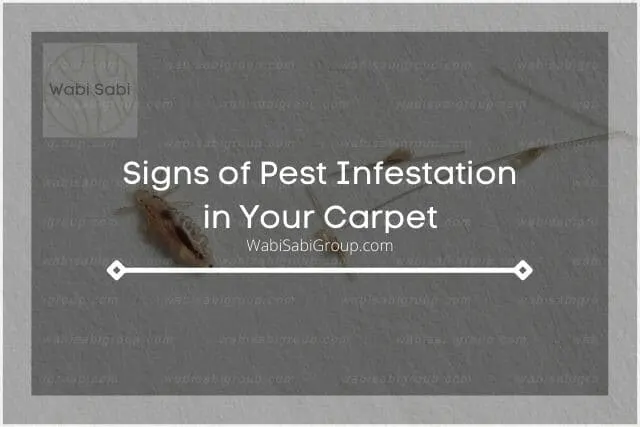
If you have bugs in your carpet, you’re probably rushing to get them out. However, you need to be careful about the bug removal method you use – some might have the potential to damage your carpet.
So, will pest control ruin your carpet?
Pest control might ruin your carpet – it depends on the method of pest control you use.
- Physical methods like vacuuming and steam cleaning won’t ruin your rug.
- Natural methods like using diatomaceous earth and soapy water are also safe for your carpet.
- Using coffee and pepper to deter ants might stain your rug.
- With chemical methods, it depends on what you use. Indoor insecticides and undiluted vinegar might be harmful to carpets. Boric acid, on the other hand, is quite safe.
The rest of this article will discuss the following topics:
- How to properly control pest infestation in your carpet
- What causes carpet bugs
- Types of carpet bugs
- Signs of pest infestation in your rug
How to Control Pest Infestation in Your Carpet

There are different methods for controlling insects invading your rug.
While some pest control methods will ruin your carpet, others won’t. The type of bug in your carpet will determine which method is appropriate.
Here are some of the best pest control methods to use:
Physical Methods
This method of controlling pests involves trapping and killing the bugs via physical means. Removing bugs physically doesn’t harm your carpet, so this should be your first resort.
Vacuuming
You can reduce the number of pests in your carpet by vacuuming it. Vacuuming sucks up insects, including the adult, larvae, and laid eggs. All you have to do is vacuum daily, paying particular attention to infested areas.
To ensure you keep the bugs away, empty the dirt into a garbage bag, seal it properly, and dispose of it outdoors.
Steam cleaning
While vacuuming only removes the pest without killing them, steam cleaning goes a step further. Not only does it remove carpet bugs, but it also kills them on the spot.
After vacuuming, you can steam clean to ensure that any pests that might have escaped are killed.
Cleaning your fabrics with high heat
Once bugs invade your carpet, they’ll increase in number rapidly and spread to other parts of your house. They’ll climb your walls, go to the window sill and even hide in fabric.
Unfortunately, if you eliminate most of them and leave out only a small fraction, they’ll repopulate extremely quickly.
As a precautionary measure, launder all the fabric in your home after cleaning. Ensure you dry with high heat to kill any pests hidden in the material. If you only treat the carpet but leave out the fabric, sooner or later, the bugs will resume infesting your carpet fibers.
Chemical Methods
This method relies heavily on pesticides. Pesticides are chemicals that can kill bugs. Most of them can also harm humans and carpets, which is why you should be careful when adopting this method.
Here are some common chemical pest control methods for carpets:
Boric acid
Boric acid is a mild chemical that you can apply to your carpet without harming yourself or your carpet.
Here’s the process:
- Vacuum your carpet and sprinkle the acid on it.
- Use a carpet rake or push broom to drive the chemical deep into the fibers.
- After two or three hours, vacuum the residue and dispose of it properly.
Because it’s mild, boric acid is slow to work. You might have to apply it several times to kill all the insects in your rug.
Vinegar
Vinegar is not only a pesticide but is also a deterrent to carpet bugs. Although it cannot kill all types of bugs, it can prevent them from living in your carpet. And applying it is safe for humans, which makes it an even more suitable choice. The most appropriate type of vinegar for this purpose is apple cider vinegar or white vinegar.
Depending on the type of carpet you have, vinegar might be harmful. The chemical is acidic and can ruin rugs made with natural materials like wool and silk.
Here’s the process from start to finish:
- Mix one half of vinegar with one half of water and pour the solution into a spray can.
- Wipe or spray surfaces of drawers, shelves, cupboards, and window sills with the solution.
- Pour some undiluted vinegar down the drain.
- Spray the diluted vinegar on your carpet. Make sure the vinegar isn’t harmful to your carpet before going ahead.
Indoor Insecticide
Indoor insecticides are more effective than many of the other methods listed here. However, they may not be suitable for your carpet.
If you must use them, you should only apply them in key locations:
· Hidden spots such as under the furniture
· In hard-to-reach shelves
· Inaccessible door corners and window frames
· Closets
· Cracks and crevices
· Baseboards
· Under the sink
· In the drain
· Any other hidden place where pests can hide
Whatever you do, don’t apply these directly to your carpet. Most indoor insecticides will ruin your carpets, clothing, and even pieces of furniture.
Before you use any insecticide, read the label on the container and see if it is suitable for carpet use. If you’re not sure, check with the manufacturer, distributor, or the outlet where you got it. Ensure you inform them of the carpet you want to use the insecticide on so they can give you accurate advice.
During application, remove children and pets from the affected room during and after treatment. Only allow them to return after the insecticide has worn off, which should take two to three hours.
Natural Methods
This method involves the use of natural products to control pests on your carpet. Natural pest control methods are nontoxic to carpets and are the preferred option if you don’t want to use chemicals.
Diatomaceous earth
Diatomaceous earth is the fossilized remnants of aquatic algae and phytoplankton. While it might seem like an odd solution on the surface, it has more than proved its usefulness in pest control.
Some homeowners and gardeners are already adopting this natural pest remedy, and it is growing more popular as the years go on.
How does it deter carpet pests?
Diatomaceous earth is deadly to carpet bugs. When observed under a microscope, it looks like a hollow cylinder enclosed in barbs. It has razor-sharp edges that penetrate the waxy coating protecting insects. The injured pest will eventually die from its injuries.
How do you apply it?
Here are some tips for applying diatomaceous earth to your carpet:
- Make sure you get a food-grade or pest-grade diatomaceous earth
- Wear protective clothing and gloves. Also wear a dust mask or respirator before applying.
- Apply diatomaceous earth under the carpet.
- Spoon some of it into a feather duster or paintbrush
- Dust the earth around the carpet edges and furniture.
- You can leave diatomaceous earth on your carpet for a week or more. It takes awhile to work, so it has to stay for several days to kill off bugs.
- Once you’re finished, vacuum up the residue
Some people prefer to apply diatomaceous earth on top of the carpet. If you do this, you won’t need to dust it under your carpet. You’ll also have to leave it for at least two hours before vacuuming off the residue.
Does it ruin your carpet?
Diatomaceous earth does not damage your carpet. However, it can irritate humans and pets. If you cough after applying it, you should vacuum it up immediately.
Soapy water
If you have ants, using soapy water is an effective way to get rid of them. The application process is simple: pour soapy water in a dispenser bottle and spray the ants as needed.
Other natural methods
Cucumbers, mint tea, cayenne pepper, citrus oil, coffee or cinnamon are also very effective against ants. If you can trace the hole where the ants are coming from, applying any of these substances to the point of entry will get rid of them quickly.
Neem oil, marigolds, citronella candles, cedar, shampoo are other natural methods you can use to control home pests.
Most of these substances will not ruin your carpet, but some of them – like coffee and cayenne pepper – can stain it.
What Causes Carpet Bugs?

If you know what causes carpet bugs to infiltrate your home, you’ll be in a better position to prevent them.
Here are some of the most common causes of insect infestation in carpets:
Poor food hygiene
Leaving food crumbs and dirty fabrics on the carpet can bring in pests, as dirty rugs are an excellent breeding ground for common carpet bugs.
Pets that go outside
Pets can easily go outside, pick up bugs, and deposit them on your carpets. One pregnant female bug is enough to cause an infestation because they reproduce quickly and in great numbers.
Storing dirty clothes for too long
Dirty clothes can also attract cloth moths. These moths love keratin, and dirty clothes provide an ample amount for them. They are attracted to dirty clothes that are kept in dark spots. There, they can hide in a rich layer of sweat, hair, and skin.
Dirty furniture fabric
Dirty furniture fabrics are also a good place for moth larvae to live and grow, as such places are keratin-rich, too.
Secluded Dirty Areas
Covered spots attract pests to your carpet. Those inaccessible corners in the house provide the pests with an undisturbed environment to live and breed. Therefore, it is advisable to vacuum clean spots under the furniture.
Types of Bugs that Damage Carpets

Bugs are not just detrimental to your comfort; they can also ruin the beautiful rugs and carpets you have carefully laid out in your home.
They cause damage by eating carpet fiber as food. Some of them also leave harmful excreted substances that can damage the fabric of your rug.
Some of the most notorious culprits are:
Carpet Moths
There are two species of carpet moths – the case-making moth and the webbing moth.
The wingspans of carpet moths are tiny, measuring between 14mm and 18mm. Adults have an easily recognizable beige or brown coloration on their backs. These pests choose dark undisturbed areas to lay their eggs, and your carpet is a perfect place for this.
Adult moths do not cause damage to your carpet. However, the problem starts when the female lays hundreds of eggs that eventually hatch into larvae.
Carpet moths reproduce in large numbers. A female lays about 100 to 150 eggs, which take about five days to hatch. After five days, you’ll have an army of caterpillars ready to feast on your rugs, carpets, and fabrics.
Carpet moth larvae are non discretionary feeders. They can eat anything, including silk, wool, cotton, and hair materials. It doesn’t matter what material is used for making your carpet; moth larvae will feast on it.
Dirt also draws the larvae to the rug because they love to nibble on the pet hair, food remains, dead insects and pollen that accumulate in your rug over time.
To keep these pests and their carpet-devouring larvae away from your home, you should adopt good hygiene and regular vacuuming habits.
Silverfish
Silverfish are common household pests. You can identify these bugs by the three large bristles they have on their rear. They also have a sleek body shaped like a teardrop. Their body color is usually brown-grey or blue silver. They’re often very short, measuring somewhere between 12mm to 19mm long.
This content is owned by Wabi Sabi Group and was first published on Sep 12, 2022..
Silverfish feed on carbohydrates like starch and dextrin. Most things that are deposited on the carpet are some form of carbohydrate. Examples include pieces of clothing, books, food crumbs, book bindings, and human dandruff. Silverfish also like to feed on household dust and synthetic fibers.
Common signs of silverfish infestation are holes in the carpet and patches of yellow stains.
Carpet Beetles
You can recognize carpet beetles by their oval bodies and their color, which is often dark or brown-black. Their wings have a varying pattern of brown, dark-yellow or white color. They are also small, measuring somewhere between 0.3cm to 0.4cm.
Like moths, the larvae of carpet beetles will eat up your carpets or rugs. They’re particularly destructive because they always exist in great numbers and will eat just about anything they come in contact with.
While adult beetles will feed on pollen and nectars, the larvae do not have what it takes to go hunting for such foods. So they settle for what they see – and if they’re living in your carpet, that means they’ll be munching on your expensive fibers.
Signs of Pest Infestation in Your Carpet

Pest infestation can be a hard thing to handle, especially if it has been going on for a while. It’s best to discover carpet bugs quickly and get to work before they colonize the home completely. If you are observant, you should see the signs of their presence.
The common signs of pest infestation are:
Moth Sightings
If you see a moth, know there is already an infestation. You might not have noticed the damaged section of your carpet yet, but if you check, you’ll discover it.
Whenever you see them flying around, check the hidden areas in your house. Look for them at the window opening, under the carpet, and beneath heavy furniture. As you lift your furniture, you might see moths flying out. You may also see larvae and dead moth.
Here are a couple of signs that these pests have infiltrated your carpet:
This article was first published on Sep 12, 2022 by Wabi Sabi Group..
- Carpet loosening. If you notice your carpets loosening up on its own, it may be a sign that moths have eaten them.
- Yellow patches. Yellow patches on your rugs are also signs that you are suffering a pest infestation. These patches are caused by bug and insect excrement.
Cocoon and Egg Sightings
Cocoons and eggs can blend in with your carpet, making them hard to see until they unleash the bugs held inside. For untrained eyes, it’s often next to impossible.
To check for the eggs of pests, check your textiles and fabrics in your closet, use a magnifying glass and look around your air ducts, wardrobes, cupboards and under furniture.
Larvae Sightings
It might be difficult to notice larvae crawling on your carpet because they love undisturbed and dark spots. Good places to search for them include around closets, wardrobes, under furniture, and on the edge where your carpets intersect with the wall.
If the bodies of the larvae have alternating light and brown stripes, you may have a carpet beetle infestation. Carpet beetle larvae have dense tufts of hair on their body, which is why they have the nickname “woolly bears.”
Fecal Pellets and Shed Skin Flakes
Carpet beetle larvae shed their skins in hidden areas. If they’re in your home, they will probably litter these skin flakes all over your carpets – especially the hidden areas.
Another good place to look for these skin flakes is on the undersides of your rugs and carpets. You can also check your wool and cloth blankets for them.
Final Thoughts

Pest infestation is a lingering problem in most homes. Bugs can damage carpets and can be a great source of discomfort to pets and humans alike. But with proper maintenance and awareness, they can be controlled and even prevented.
Related Articles
8 Best Ways To Clean A Carpet On Boats
Should You Steam Clean a New Carpet?
Is Professional Carpet Cleaning Really Worth It?
WabiSabi Group is the owner of this article and was published on Sep 12, 2022 and last modified on .
